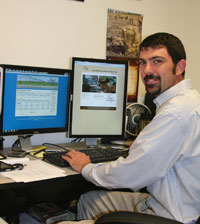
Farming + Technology
It Grows Together
Story and Photo by Macy Hindman
With the continued drought in Texas, and a decline in the availability of water from the Ogallala Aquifer, farmers are struggling to keep enough moisture on crops to earn a profit.
Farmers now have the opportunity to use new web-based tools to help make production decisions. Texas Tech University and the Texas Alliance for Water Conservation (TAWC) released the TAWC Solutions Tools. The tools help farmers make decisions to maintain a profitable crop.
“This is a stand-alone program on a website; it requires nothing more from the grower than for them to log in and create a username and password,” said Justin Weinheimer, a research associate in agricultural and applied economics at Texas Tech.
The two TAWC tools are the Resource Allocation Analyzer and the Irrigation Scheduling Tool. Weinheimer said these programs are very unique because they are free of charge, farmer-friendly and simple to use.
The Irrigation Scheduling Tool is designed to help farmers and producers get the most out of their irrigation schedule, while increasing awareness of water resources. Additionally, the tool uses weather data to help farmers decide on the best time to irrigate crops. The tool is linked to 64 of the Texas Tech Mesonet weather stations across the South Plains and Rolling Plains. Farmers are able to log in to the website and select the weather station closest to their fields. The Mesonet allows farmers to check weather conditions in their area to help decide on the best times to irrigate and amount of moisture to give crops.
The Resource Allocation Analyzer tool provides the farmer with planning options to boost crop profits and utilize irrigation water to its greatest potential. Using the Resource Allocation Analyzer tool allows farmers to evaluate five different crops, including: cotton, corn, wheat, sorghum and sunflowers.
When using the Resource Allocation Analyzer tool, the farmer inputs a series of information: crop type, contracted acres, maximum yield, irrigation required, production costs and expected price. The Resource Allocation Analyzer will then examine all the information and present the farmer with several suggestions to help maximize profits.
Since water from the Ogallala Aquifer is being used faster than it’s being replenished, the amount of irrigation water available is decreasing. These tools focus on saving water when there is opportunity for the farmer to save water. This tool provides the farmer with ideas that allow them to save water and, at the same time, maintain profits.
“Every farmer is different, every field is different, there are different soil types, different fertility rates within that soil, different capabilities with that field,” said Weinheimer.
Weinheimer said he, as well as the other creators of the tools, wanted to account for the different soil types and productivity levels of the field.
Farmers and producers do not have to link this program to a pivot or a GPS. It also does not require the farmer to download any type of program to a computer and does not require the farmer or producer to pay a yearly or monthly subscription for use of the tools.
The TAWC Solutions Tools are funded by the Texas Water Development Board (TWBD) through the TAWC until the first part of 2014. With the funds provided by the TWDB, the website has been updated and new information can be added at any time for improvements.
About 5,000 acres of land are currently being used for TAWC tools research. With increased funds, the project will be expanded to include an additional 15 to 20 fields for further research.
Farmers from around the Pampa area, to as far south as Big Lake, and from Seymour to Tatum, N.M. have the availability to use these tools as they are within the Mesonet coverage area.
“Currently we have about 120 users signed up with usernames, but some of those users are crop consultants,” said Rick Kellison, project director for the TAWC project.
Since the release of the TAWC Solutions in 2010, Kellison said, the user population on the website has increased each month.
Weinheimer also said, with additional funding, the TAWC would like to make at least one of the tools an application for iPhone users. With the new generation of technology, the TAWC would like for farmers to have the ability to use the tools while working in the field.
Farmers or producers who are interested in these tools are able to go online at www.tawcsolutions.org and try the tools for free.